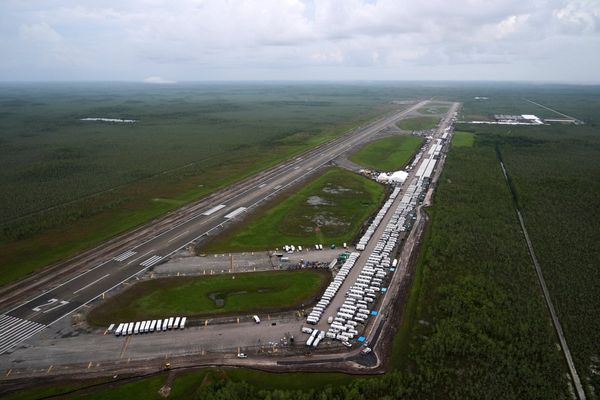
The 2023 Japan Mobility Show kicks off at the Tokyo Big Sight venue from October 28 through November 5, 2023, with press preview days just prior. It won’t surprise you to learn that Yamaha, like other manufacturers, has been hard at work getting its display together for this year’s big event.
On October 11, 2023, Yamaha revealed exactly how hard it’s gone on those preparations. There are a lot of interesting things to explore here, so we’ll dive right in.
Yamaha’s Categorizations for Vehicles It’s Displaying
First things first: While Yamaha is showing several world premiere vehicles at the 2023 Japan Mobility Show, it doesn’t refer to any of its vehicles with the word “concept.” Instead, it calls them all “reference vehicles.”
Several other items that the company plans to display are either labeled as “special exhibits” or “special exhibits with cooperation from Yamaha Corporation” in the case of displays where two branches of the larger Yamaha organization have collaborated. Other labels for vehicles include “competition machine,” “upcoming production vehicle,” and “production vehicle,” which are straightforward and self-explanatory.
Of the six World Premiere vehicles that Yamaha is displaying at the 2023 Japan Mobility Show, four fall into the category of powered two- and three-wheelers. There’s the Motoroid2, which is the next evolution of the original Motoroid concept that Yamaha unveiled in 2017 at the Tokyo Motor Show.
Then there’s the Tricera, which appears on first glance to be a competitor to the Polaris Slingshot. The ELove is a self-balancing electric scooter. Finally, the E-FV (or EFV; Yamaha itself writes it two different ways, depending on where you look) is an electric sportbike concept.
Another vehicle of interest that is not a world premiere, but that will be on display at the Yamaha booth, is the TMW offroad three-wheeler that uses Yamaha’s proprietary leaning multi-wheel technology. For those familiar with Yamaha’s Tricity and Tritown, this is essentially their off-road cousin.
Yamaha Motoroid2





According to Yamaha, ways in which the Motoroid2 has advanced beyond the OG Motoroid include becoming “a vehicle for personal mobility that can recognize its owner, get up off its kickstand, and move alongside its rider, but also has a distinctly lifelike feel when somebody is riding on its back and has a presence more like a lifetime companion.”
To achieve this, Yamaha has developed technology that it calls an “Active Mass Center Control System” (AMCES) for things like self-balancing and facial recognition. In the future, Yamaha says that “[its] development ideal …seeks to deliver users the seductive exhilaration felt when they truly become one with their machine.” Human/motorcycle hybrid, anyone?
Yamaha Tricera

If you feel like you’re looking at a more rounded, less angular take on a Polaris Slingshot, you’re not alone. There are some important differences, though. First of all, the Tricera is electric. Second of all, it offers three-wheel steering, and includes a manual mode that drivers can select to steer that rear wheel.
Yamaha ELove

The Yamaha ELove utilizes what Yamaha calls its Advanced Motorcycle Stabilization Assist System (AMSAS) to effectively create a self-balancing two-wheeled vehicle. This, Yamaha says, allows riders to not have to worry about the difficulties of balancing at slow speeds or when stopped.
Yamaha isn’t alone in developing this type of technology, with several other firms (most notably Honda) having introduced concepts along this same line of thinking in recent years. Proponents envision a safer riding environment, and tout potential benefits for new and inexperienced riders, as well as disabled riders who might not previously have been able to ride a two-wheeled vehicle.
Yamaha E-FV



The Yamaha E-FV (or EFV) stands for “Electric Fun Vehicle,” which you can see if you look closely at the bodywork on the electric motorcycle. It’s a minibike, and it uses the same powertrain as Yamaha’s existing TY-E electric trials bike. To this, it adds the Yamaha Corporation’s Active Sound Control technology, which pipes in recorded engine sounds when you turn the bike on or off.
Yamaha TMW



The Yamaha TMW was developed by Yamaha Motorcycle Testing Division volunteers who were playing around and came up with a rather interesting idea. What if you took a Yamaha Leaning Multi-Wheel vehicle, but you gave it more off-road capability? Thus, the TMW has its front two wheels move independently from the rear.
Given the fact of the existing Yamaha LMW linkage, it’s able to keep whatever is mounted on its front carrier stable, no matter what kind of inclines a rider may encounter. The TMW features a hybrid engine setup, with electric hub-mounted motors in the two front wheels and a gasoline engine powering the rear wheel.
Gallery: Yamaha Motoroid2, Tricera, ELove, EFV, and TMW














